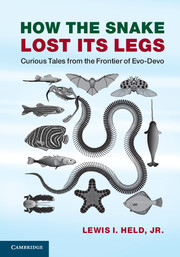2 - The fly
Published online by Cambridge University Press: 05 June 2014
Summary
How the fly got its gyroscopes
Flies are the hummingbirds of the insect world [2342]. They dart and hover and seem to delight in evading pursuers [543]. In contrast, their butterfly cousins are typically more like pelicans that flap and glide and languidly survey the scenery below [483], though butterflies do have a few aeronautic tricks of their own [2099,2497].
What gives flies their midair agility? It is a pair of gyroscopes called halteres [1784]. Halteres are club-shaped outgrowths of the thorax that oscillate up and down when the fly is airborne [542]. Deprived of these powerful stabilizers, flies spin out of control and crash clumsily to earth, often landing helplessly on their backs as if drunk [689].
Halteres evolved from hindwings, which are still present in butterflies and most other insects [336]. Indeed, flies belong to an order called Diptera because they only have two (di-) wings (-ptera) [1839].
Could a four-winged insect have evolved into a two-winged one without making itself so unsteady that it could not fly? Perhaps [254], because removing the hindwings of a butterfly does not prevent it from flying, and such amputees can even steer along prescribed flight paths, albeit more slowly [1946].
Given this redundancy in the airfoils of four-winged insects, could halteres have evolved from forewings instead of hindwings? Yes. A comparable conversion of the forewings occurred in strepsipterans – an obscure order of twisted-wing parasites [1623]. From the standpoint of dipterans, strepsipterans look as silly as horses with their saddles strapped on backward [2382]. Like strepsipterans, coleopterans (beetles) fly with only their hindwings, but they turned their forewings into protective covers (elytra) instead of halteres [56,337].
- Type
- Chapter
- Information
- How the Snake Lost its LegsCurious Tales from the Frontier of Evo-Devo, pp. 15 - 42Publisher: Cambridge University PressPrint publication year: 2014



